Decoupling Analysis of Net Carbon Emissions and Economic Growth of Marine Aquaculture
Abstract
:1. Introduction
2. Literature Review
3. Materials and Methods
3.1. Methods
3.1.1. Accounting Method for Net Carbon Emissions of Marine Aquaculture
- (1)
- Calculation of the carbon emissions of marine aquaculture
- (2)
- Estimation of carbon sequestration in marine aquaculture
- (3)
- Accounting of net carbon emissions from marine aquaculture
3.1.2. Tapio Decoupling Index Model
3.1.3. Tapio Decoupling Effort Index Analysis Model
- (1)
- Decomposition of the LMDI index of net carbon emissions.
- (2)
- Tapio decoupling index.
3.2. Data Collection
4. Empirical Results and Analysis
4.1. Analysis of Decoupling Characteristics between Net Carbon Emissions and Economic Growth of Marine Aquaculture
4.1.1. Analysis of Overall Decoupling Characteristics
4.1.2. Analysis of Decoupling Characteristics in Sub-Sea Area
4.1.3. Analysis of Decoupling Characteristics in Sub-Province
4.2. Decoupling Effort Index Analysis
4.2.1. Decomposition Analysis of Influencing Factors of Net Carbon Emissions from Marine Aquaculture
- (1)
- Decomposition analysis of factors influencing overall net carbon emissions.
- (2)
- Decomposition analysis of factors influencing the net carbon emissions in sub-sea area.
- (3)
- Decomposition analysis of factors influencing net carbon emissions in sub-province.
4.2.2. Analysis of Decoupling Effort Indicators
- (1)
- Analysis of overall decoupling effort indicators.
- (2)
- Analysis of decoupling effort indicators in the sub-sea area.
- (3)
- Analysis of decoupling effort indicators in sub-province.
4.3. Further Analysis
5. Conclusions and Discussion
- (1)
- The relationship between the net carbon emissions and the economic growth of marine aquaculture generally shows a decoupling state (from Figure 1), but the decoupling relationships in different regions are different, which is similar to the findings of Kong (2021) [40]. In terms of sea areas, the southern ocean economic zone has the most ideal decoupling state, the trend of eastern ocean economic zone is “decoupling–coupling” while the northern ocean economic zone has the trend of “negative decoupling–decoupling–negative decoupling” (from Table 4). In terms of province, Zhejiang, Fujian, Guangdong, and Guangxi are in good decoupling states, while the decoupling status of Shandong continues to deteriorate (combined with Table 5 and Figure 2).
- (2)
- There is a big difference in the total net carbon emissions effects of marine aquaculture in China (from Table 6). In terms of sea areas, the total net carbon emissions effect of the northern ocean economic zone is weaker than those of the eastern and southern ocean economic zones (from Figure 3). In terms of province, Fujian and Guangxi have the best total net carbon emissions effects, while Hainan and Jiangsu have the worst total effects (from Figure 4).
- (3)
- Based on the factors driving the net carbon emissions of marine and aquaculture, carbon emission intensity is the most important driving factor, which is very similar to the results of Wang and Wang [20]. Specific to the coastal areas of China, carbon emission intensity and aquaculture efficiency are the most important factors (from Table 6). In terms of sea areas, the carbon emission intensity and aquaculture efficiency effect are the main factors, and the aquaculture scale effect is also obvious in promoting the southern ocean economic zone (from Figure 3). In terms of provinces, carbon emission intensity, aquaculture efficiency, and aquaculture scale effect are the three most important driving factors. The carbon emission intensity effect makes the most significant contribution to the total net carbon emissions effect, and the aquaculture efficiency effect is better than the aquaculture scale effect (from Figure 4).
- (4)
- As for the degree of efforts to decouple the net carbon emissions from the economic growth of marine aquaculture, in terms of sea areas, the eastern and southern ocean economic zones make strong decoupling efforts, while the northern ocean economic zone makes weak decoupling efforts. In terms of province, Fujian (15.10), Guangxi (3.18), Hainan (2.26), Guangdong (1.95), and Liaoning (1.18) make strong decoupling efforts, while Shandong (−6.10), Hebei (−5.35), and Zhejiang (−0.17) make the weakest decoupling efforts. From the decoupling effort index of the net carbon emissions and economic growth of marine aquaculture, the order of efforts of various factors in different sea areas is carbon emission intensity > aquaculture scale > aquaculture structure > aquaculture efficiency (from Figure 5).
- (1)
- Strengthen regional cooperation and explore diversified ways to reduce emissions and increase the carbon sink. Because of the spatial correlation between regions, regional synergy should be included to promote an emissions reduction and carbon sink increase in marine aquaculture through diversified means. On the one hand, we should acknowledge the active and leading role of the government and other administrative departments in the formulation of relevant policies and regulations [41]. On the other hand, we can improve the pilot and market-oriented mechanism of carbon exchange trading in the fishery culture and encourage the development of carbon sink enhancement projects to promote the healthy development of the blue carbon industry.
- (2)
- Build a modern three-dimensional aquaculture system and adjust the scale of marine aquaculture according to local conditions. Based on the decoupling contribution degrees of various factors, the aquaculture scale plays an extremely important role. A reasonable aquaculture scale will promote the decoupling of net carbon emissions and economic growth (such as the southern ocean economic zone). China is rich in marine space resources, but there are still many shallow beaches that have not been used [21]. Owing to the heterogeneity of geographical locations and marine resources in various provinces, we should combine the local marine ecological–economic–social status, make full use of the advantages and advanced technologies, form the scale advantage of marine aquaculture with regional characteristics by establishing a modern three-dimensional aquaculture system, and maximize the economic benefits of marine aquaculture.
- (3)
- Vigorously develop green ecological aquaculture and continuously optimize the aquaculture structure. Judging by the contribution degrees of the decoupling efforts in sea areas, the contribution degree of aquaculture structure is insufficient or even reversed (such as the northern ocean economic zone), which may be related to the lack of diversity in marine aquaculture species and the low technical content of aquaculture methods in China [42]. Therefore, we should focus on new models and the extension of deep-sea pastures, increasing the proportion of green ecological aquaculture industries such as leisure fisheries, and continuously optimizing the marine aquaculture structure to promote marine aquaculture, so as to release more blue carbon space while reducing carbon.
- (4)
- Build a modern marine aquaculture economic system and improve aquaculture efficiency. According to the redundancy efficiency analysis results of various factors, the redundant efficiency of the aquaculture area and labor force are the most important factors affecting comprehensive efficiency, and the rational use of resource endowment is the key to improving the efficiency of marine aquaculture. Therefore, we should improve the efficiency and carbon sink function of marine aquaculture by building an intelligent marine resource management system and promoting multi-level integrated aquaculture, so as to lay the foundation for the sustainable development of marine aquaculture with high quality, high efficiency, and low carbon.
Author Contributions
Funding
Institutional Review Board Statement
Informed Consent Statement
Data Availability Statement
Conflicts of Interest
References
- Liu, P.; Sun, P.; Song, H.J.; Wang, Z.X.; Li, R.X. Temporal and spatial variation characteristics of phytoplankton community in different aquaculture areas of Sanggou Bay. Prog. Mar. Sci. 2019, 37, 673–680. [Google Scholar]
- Hamdiyah, S.; Supriatna, J.; Prihanto, Y.; Adi, N.S.; Pranowo, W.S. Social and economic influences on CO2 emission from capture fisheries in West Java Province. IOP Conference Series: Earth and Environmental Science. IOP Publ. 2020, 530, 012026. [Google Scholar]
- Zhang, F.; Chen, Y.; Chen, Q.; Feng, Y.; Shang, Y.; Yang, X.; Gao, H.; Tian, C.; Li, J.; Zhang, G.; et al. Real-World Emission Factors of Gaseous and Particulate Pollutants from Marine Fishing Boats and Their Total Emissions in China. Environ. Sci. Technol. 2018, 52, 4910–4919. [Google Scholar] [CrossRef]
- Yang, H. Resource advantages of Yueqing Bay in Zhejiang Province and the treatment of contradictions in its development. Ocean Bull. 2003, 6, 49–55. [Google Scholar]
- Macusi, E.; Estor, D.E.; Borazon, E.; Santos, M. Environmental and Socioeconomic Impacts of Shrimp Farming in the Philippines: A Critical Analysis Using PRISMA. Sustainability 2022, 14, 2977. [Google Scholar] [CrossRef]
- Ouyang, X.G.; Lee, S.; Wang, W.Q. The ‘Perfect’ Conversion: Dramatic Increase in CO2 Efflux from Shellfish Ponds and Mangrove Conversion in China. Sustainability 2021, 13, 13163. [Google Scholar] [CrossRef]
- Li, X.; Li, Z.; Su, C.W.; Umar, M.; Shao, X.F. Exploring the asymmetric impact of economic policy uncertainty on China’s carbon emissions trading market price: Do different types of uncertainty matter? Technol. Forecast. Soc. Chang. 2022, 178, 121601. [Google Scholar] [CrossRef]
- Wang, Y.Y.; Guo, T.T.; Cheng, T.C.E.; Wang, N. Evolution of blue carbon trading of China’s marine ranching under the blue carbon special subsidy mechanism. Ocean Coast. Manag. 2022, 222, 106123. [Google Scholar] [CrossRef]
- Liu, K.; Bian, Y.; Wang, Y.Y.; Liu, G.C.; Zhang, Y.G. Study on marine carbon sequestration accounting and influencing factors of carbon emission in island areas—A case study of Changhai County, Liaoning Province. Resour. Dev. Mark. 2019, 35, 632–637. [Google Scholar]
- Zhang, Y.N. Impact of optimization of marine fishery industrial structure on carbon emission efficiency—Based on spatial econometric analysis of China’s coastal areas. Ocean Dev. Manag. 2021, 38, 3–15. [Google Scholar]
- Zhang, Y.; Ji, J.Y. Coupling relationship and driving factor decomposition of mariculture eco-economic system in China. Agric. Technol. Econ. 2020, 4, 94–106. [Google Scholar]
- Shao, G.L.; Liu, B.; Li, C. Assessment of carbon sink capacity of mariculture in China’s main sea areas and its impact effect—Based on the panel data of 9 coastal provinces in China. J. Ecol. 2019, 39, 2614–2625. [Google Scholar]
- Han, L.M.; Ren, G.Y.; Qin, H. The basic connotation and particularity of “three fisheries”. Agric. Econ. Issues 2007, 122, 93–96. [Google Scholar]
- Chen, J.; Wang, Y.; Song, M.; Zhao, R. Analyzing the decoupling relationship between marine economic growth and marine pollution in China. Ocean Eng. 2017, 137, 1–12. [Google Scholar] [CrossRef]
- Peng, D.; Yang, Q.; Yang, H.J.; Liu, H.; Zhu, Y.; Mu, Y. Analysis on the relationship between fisheries economic growth and marine environmental pollution in China’s coastal regions. Sci. Total Environ. 2020, 713, 136641. [Google Scholar] [CrossRef]
- Yue, D.D.; Wang, L.M. Research on the development path and stage division of low-carbon fisheries in China. J. Ocean Univ. China 2012, 9, 15–21. [Google Scholar]
- Li, C.; Li, H.Y.; Kong, H.Z.; Feng, W. Structural characteristics of implied carbon emissions in Chinese fishery production system and decomposition of driving factors. Resour. Sci. 2021, 43, 1166–1177. [Google Scholar]
- Zhang, J.W.; Dai, Y.; Su, C.W.; Kirikkaleli, D.; Umar, M. Intertemporal change in the effect of economic growth on carbon emission in China. Energy Environ. 2021, 32, 1207–1225. [Google Scholar] [CrossRef]
- Li, C.; Chi, P.; Shao, G.L. Research on the Response Relationship between China’s Offshore Fisheries Carbon emissions and Industry Economic Growth—An Empirical Analysis Based on Decoupling Theory and LMDI Decomposition. Sci. Technol. Manag. Res. 2016, 36, 233–237. [Google Scholar]
- Wang, Q.; Wang, S.S. Carbon emission and economic output of China’s marine fishery—A decoupling efforts analysis. Mar. Policy 2022, 135, 104831. [Google Scholar] [CrossRef]
- Zhang, J.H.; Liu, J.H.; Zhang, Y.Y.; Li, G. Ways to practice “negative marine emissions” in mariculture. J. Chin. Acad. Sci. 2021, 36, 252–258. [Google Scholar]
- Driscoll, J.; Tyedmers, P. Fuel use and greenhouse gas emission implications of fisheries management: The case of the new England Atlantic herring fishery. Mar. Policy 2010, 34, 353–359. [Google Scholar] [CrossRef]
- Machado, F.; Halmenschlager, V.; Abdallah, P.R.; Teixeira, G.; Sumaila, U.R. The relation between fishing subsidies and CO2 emissions in the fisheries sector. Ecol. Econ. 2021, 185, 107057. [Google Scholar] [CrossRef]
- Zhang, W.K.; Luo, Q.; Liu, S.Y. Is government regulation a push for corporate environmental performance? Evidence from China. Econ. Anal. Policy 2022, 74, 105–121. [Google Scholar] [CrossRef]
- Shao, G.L.; Kong, H.Z.; Yu, J.K.; Li, C. Decomposition of driving factors of carbon emissions from marine aquaculture in China based on LMDI method. Agric. Technol. Econ. 2015, 9, 119–128. [Google Scholar]
- Jiao, N.Z. Research and development of marine “negative emission” technology to support the national demand for “carbon neutralization”. J. Chin. Acad. Sci. 2021, 36, 179–187. [Google Scholar]
- Devi, M.S.; Xavier, K.; Singh, A.S.; Edwin, L.; Shenoy, L. Environmental pressure of active fishing method: A study on carbon emission by trawlers from north-west Indian coast. Mar. Policy 2021, 127, 104453. [Google Scholar] [CrossRef]
- Orr, J.C.; Sarmiento, J.L. Potential of marine macroalgae as a sink for CO2: Constraints from a 3-D general circulation model of the global ocean. Water Air Soil Pollut. 1992, 64, 405–421. [Google Scholar] [CrossRef]
- Ji, J.Y.; Wang, P.P. Measurement of carbon sequestration capacity of mariculture in China and decomposition of influencing factors. Mar. Environ. Sci. 2015, 34, 871–878. [Google Scholar]
- Yang, Y.F.; Luo, H.T.; Wang, Q.; He, Z.L.; Long, A.M. Large-scale cultivation of seaweed is an effective way to increase ocean carbon sink and solve offshore environmental problems. J. Chin. Acad. Sci. 2021, 36, 259–269. [Google Scholar]
- Zhang, X.X.; Zheng, S.; Yu, L.H. Measurement of green efficiency of China’s marine carbon sink fishery and its spatial spillover effect. China’s Rural Econ. 2020, 10, 91–110. [Google Scholar]
- Zhang, Y.Y.; Zhang, J.H.; Liang, Y.T. Formation process and mechanism of carbon sink in China’s offshore aquaculture environment. Chin. Sci. Earth Sci. 2017, 47, 1414–1424. [Google Scholar]
- Shao, G.L.; Kong, H.Z.; Li, C. Net carbon sink of mariculture in China and its coupling relationship with economy. Resour. Sci. 2019, 41, 277–288. [Google Scholar]
- Sun, K.; Cui, Q.Q.; Su, Z.X.; Wang, Y.N. Spatio-temporal evolution of economic value of carbon sink in mariculture in China and analysis of influencing factors. Geogr. Res. 2020, 39, 2508–2520. [Google Scholar]
- Zhou, L. Research on China’s Low-carbon Economic development Based on Tapio Model. Explor. Econ. Probl. 2019, 06, 185–190. [Google Scholar]
- Tapio, P. Towards a theory of decoupling: Degrees of decoupling in the EU and the case of road traffic in Finland between 1970 and 2001. Transp. Policy 2005, 12, 137–151. [Google Scholar] [CrossRef] [Green Version]
- Kaya, Y. Impact of Carbon Dioxide Emission on GNP Growth: Interpretation of Proposed Scenarios. In Paris: Presentation to the Energy and Industry Subgroup, Response Strategies Working Group; IPCC: Geneva, Switzerland, 1989. [Google Scholar]
- Ang, B.; Zhang, F.; Choi, K.H. Factorizing changes in energy and environmental indicators through decomposition. Energy 1998, 23, 489–495. [Google Scholar] [CrossRef]
- Diakoulaki, D.; Mandaraka, M. Decomposition analysis for assessing the progress in decoupling industrial growth from CO2 emissions in the EU manufacturing sector. Energy Econ. 2007, 29, 636–664. [Google Scholar] [CrossRef]
- Kong, F.Z.; Cui, W.L.; Xi, H.H. Spatial–temporal variation, decoupling effects and prediction of marine fishery based on modified ecological footprint model: Case study of 11 coastal provinces in China. Ecol. Indic. 2021, 132, 108271. [Google Scholar] [CrossRef]
- Zhang, W.; Meng, J.; Tian, X. Does de-capacity policy enhance the total factor productivity of China’s coal companies? A Regression Discontinuity design. Resour. Policy 2020, 68, 101741. [Google Scholar] [CrossRef]
- Qin, H.; Ye, C.C.; Zhang, Y. Study on the state evaluation of mariculture eco-economic system-taking Shandong Province as an example. Econ. Issues 2017, 113, 100–105. [Google Scholar]
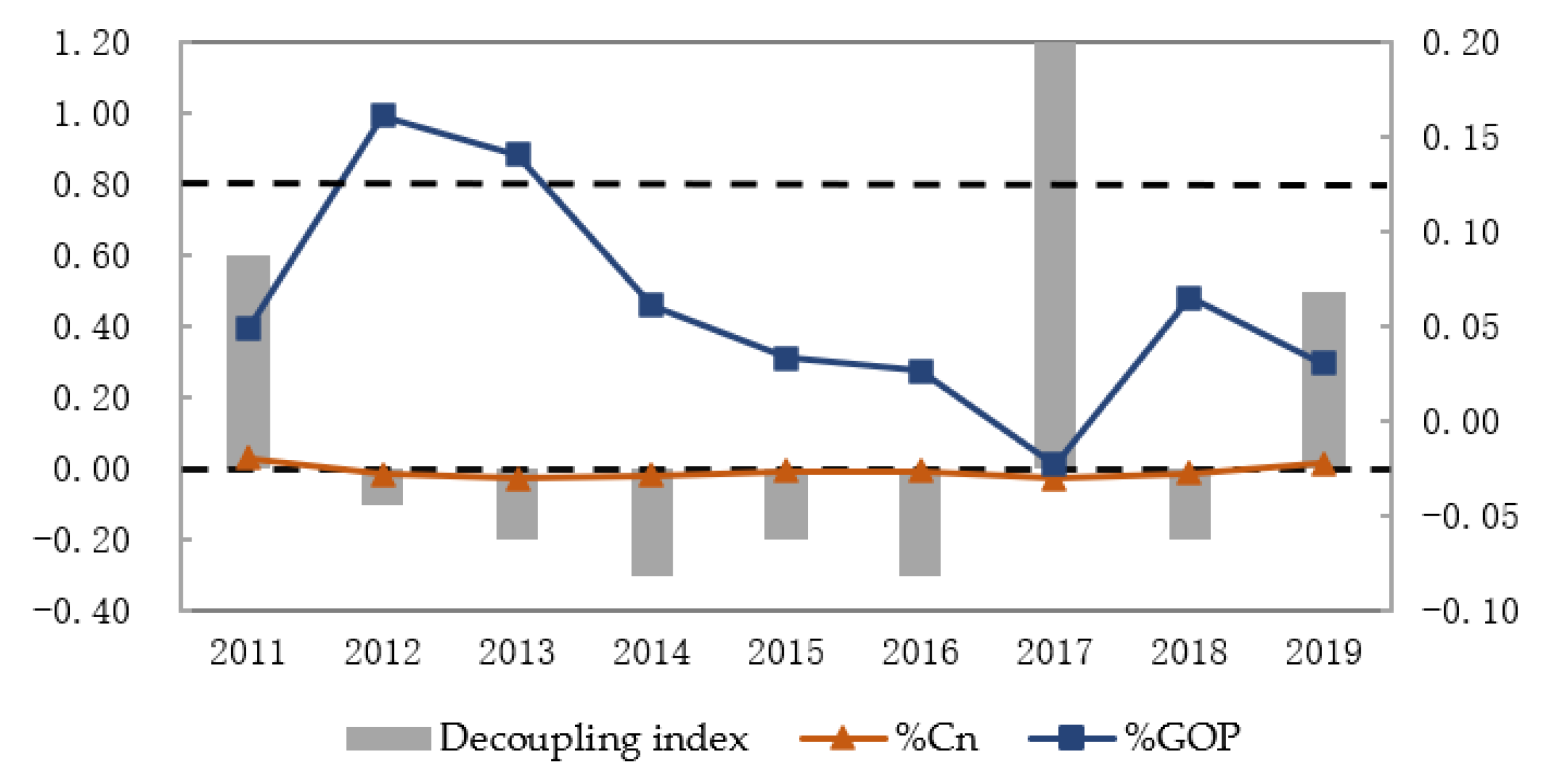
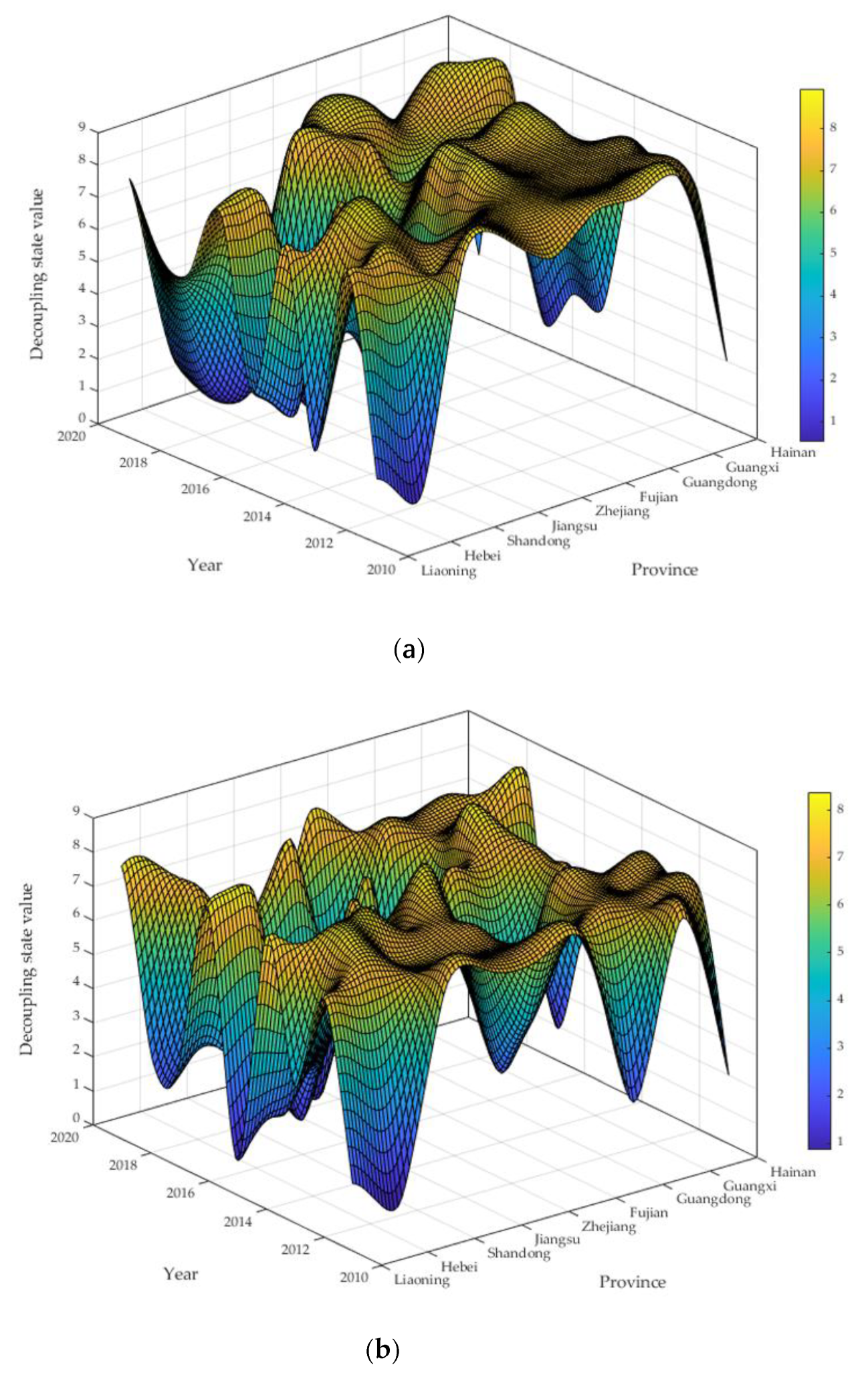
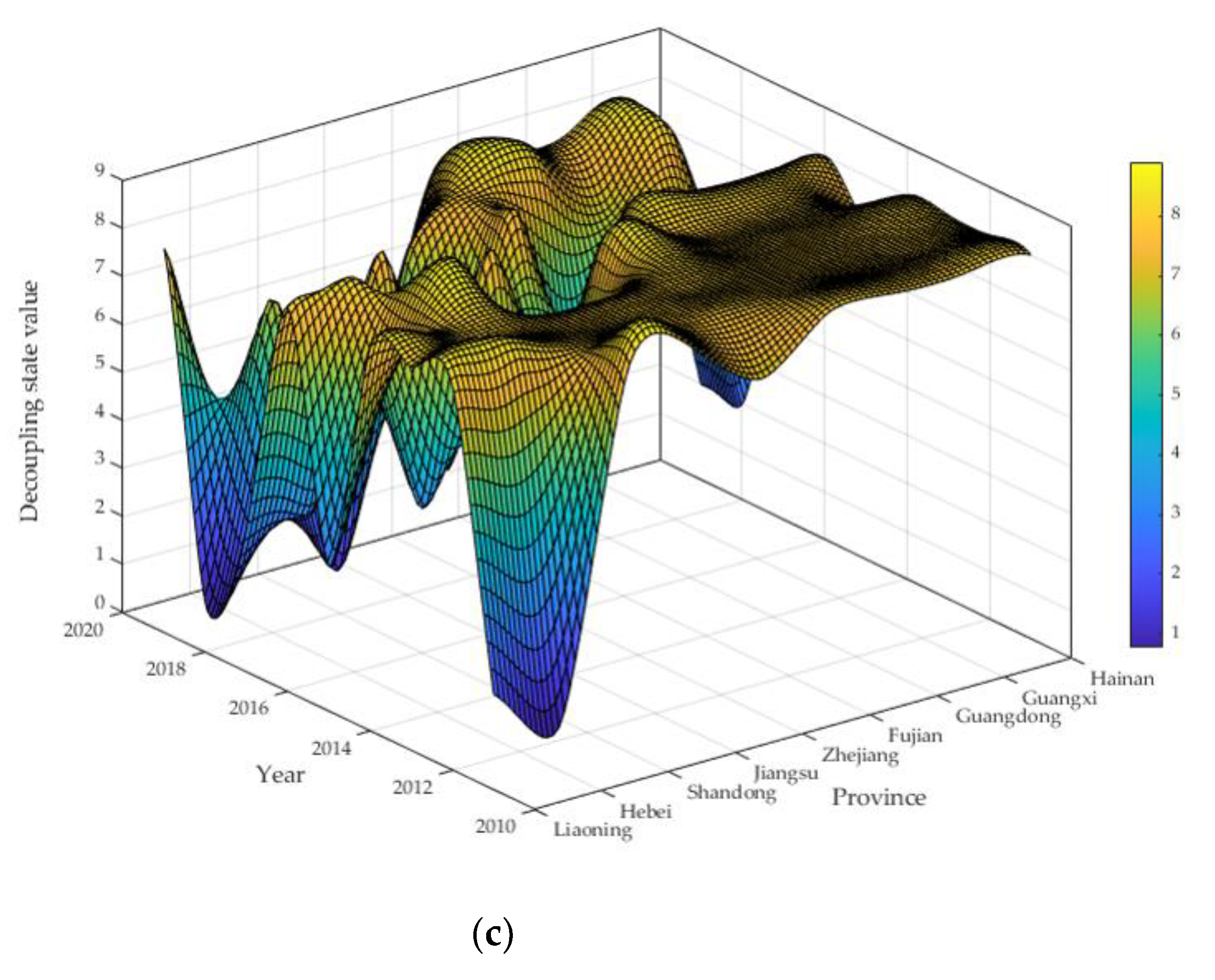

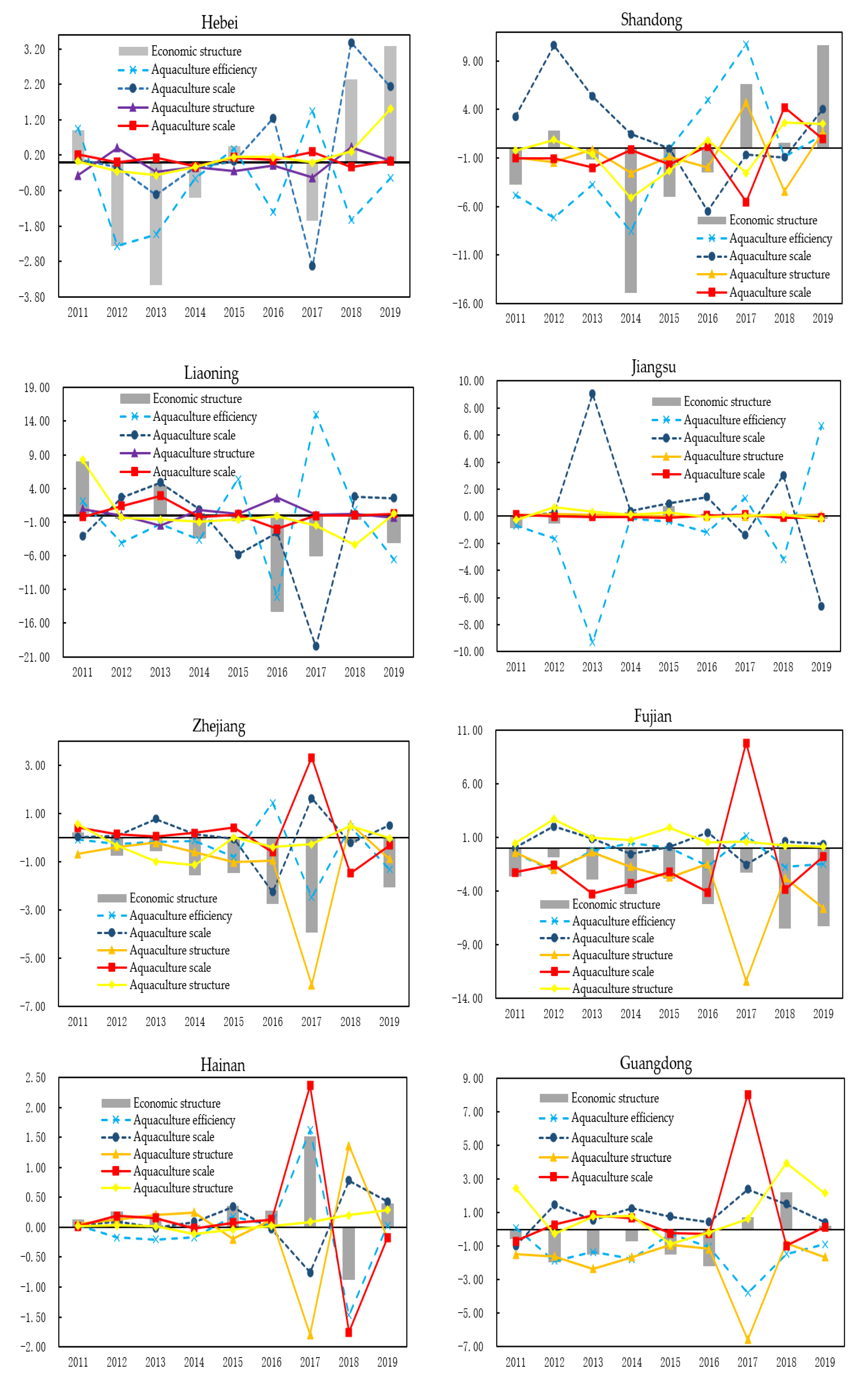
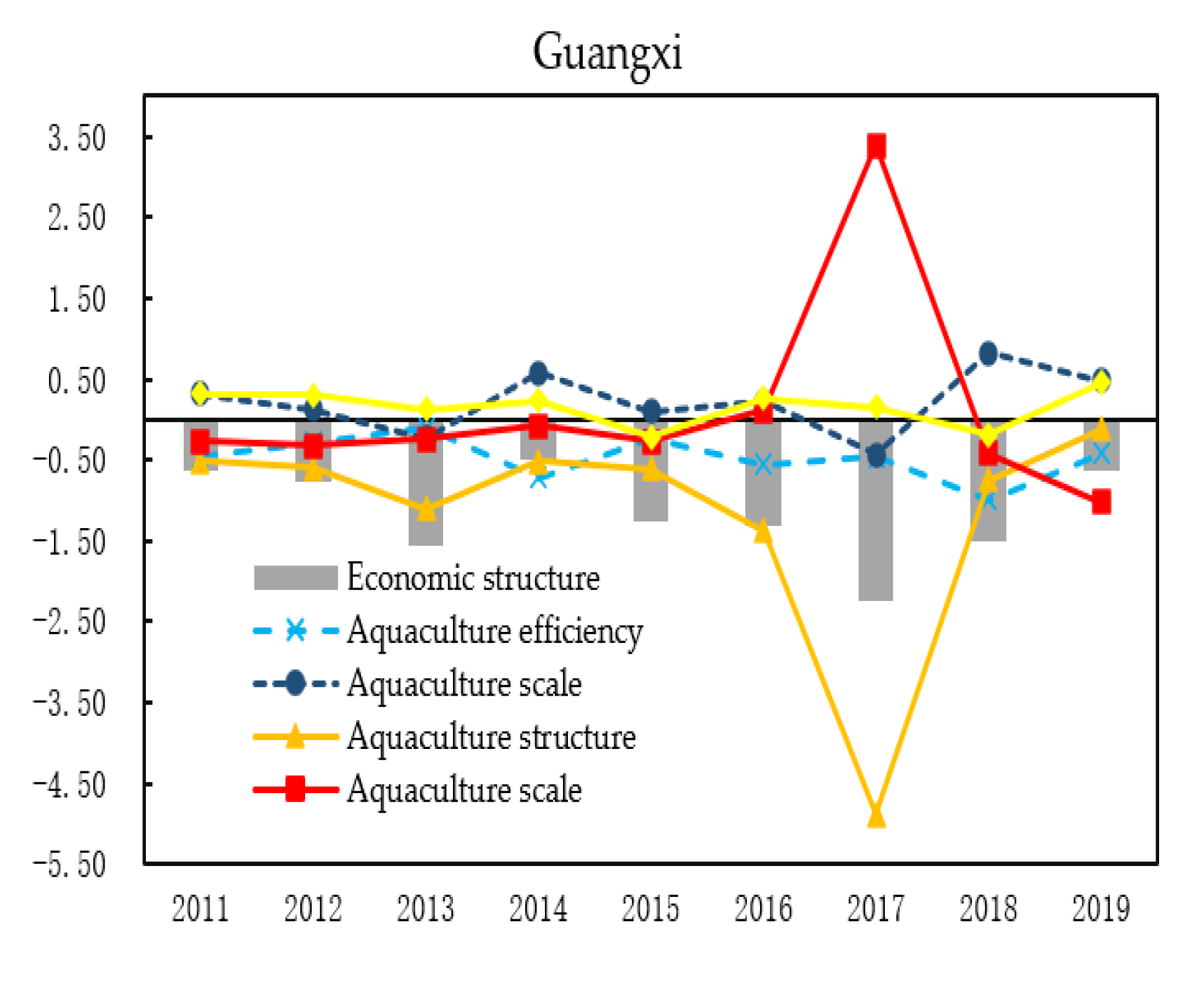
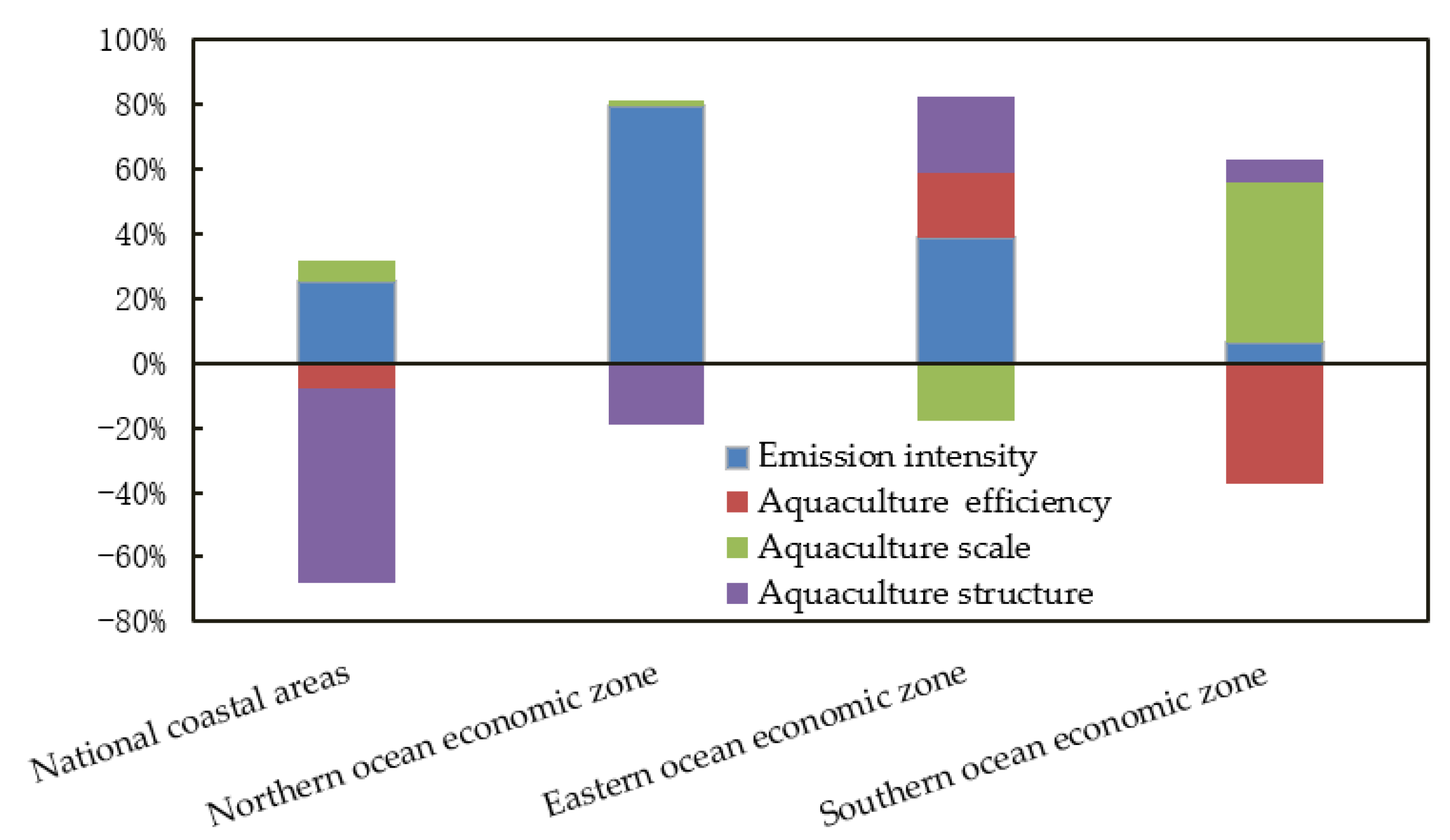
| Energy Category | Energy Consumption Conversion Coefficient (kg/kg Standard Coal) | Aquaculture | Conversion Coefficient of Energy Consumption |
|---|---|---|---|
| Diesel | 0.5921 | Pond culture | 0.1495 |
| Electric power | 0.6800 | Factory culture | 3.4977 |
| Shellfish | Carbon Sink Conversion Coefficient % | Algae | Carbon Sink Conversion Coefficient % |
|---|---|---|---|
| Oysters | 9.59 | Kelp | 6.24 |
| Mussels | 10.93 | Wakame | 5.28 |
| Scallops | 10.17 | Nori | 5.48 |
| Clam | 6.40 | River hedge | 4.12 |
| Other shellfish | 9.72 | Other algae | 5.55 |
| Decoupling State | Meaning | Decoupling Status | ||||
|---|---|---|---|---|---|---|
| Decoupling | Strong decoupling | rise, the best state | 8 | |||
| Weak decoupling | rises faster | 7 | ||||
| Recessive decoupling | falls faster than GOP | 6 | ||||
| Coupling | Recessive coupling | both decline, the decline rate is the same | 5 | |||
| Expansive coupling | both rise, the growth rate is the same | 4 | ||||
| Negative decoupling | Weak negativedecoupling | 3 | ||||
| Expanding negative decoupling | 2 | |||||
| Strong negativedecoupling | declines, the worst state | 1 | ||||
| Region | 2010–2011 | 2011–2012 | 2012–2013 | 2013–2014 | 2014–2015 | 2015–2016 | 2016–2017 | 2017–2018 | 2018–2019 |
|---|---|---|---|---|---|---|---|---|---|
| Northern | 2 | 8 | 8 | 8 | 8 | 6 | 3 | 2 | 2 |
| Eastern | 8 | 8 | 8 | 8 | 8 | 6 | 8 | 8 | 5 |
| Southern | 8 | 8 | 8 | 8 | 8 | 8 | 8 | 8 | 8 |
| Region | 2010–2011 | 2011–2012 | 2012–2013 | 2013–2014 | 2014–2015 | 2015–2016 | 2016–2017 | 2017–2018 | 2018–2019 |
|---|---|---|---|---|---|---|---|---|---|
| Hebei | 1 | 8 | 8 | 8 | 2 | 8 | 6 | 2 | 2 |
| Liaoning | 2 | 8 | 2 | 8 | 3 | 8 | 6 | 6 | 8 |
| Shandong | 8 | 7 | 8 | 8 | 8 | 3 | 2 | 1 | 2 |
| Jiangsu | 8 | 8 | 7 | 2 | 1 | 4 | 1 | 8 | 3 |
| Zhejiang | 7 | 8 | 8 | 8 | 8 | 6 | 8 | 8 | 8 |
| Fujian | 8 | 8 | 8 | 8 | 8 | 8 | 6 | 8 | 8 |
| Guangdong | 8 | 8 | 8 | 8 | 8 | 8 | 7 | 7 | 7 |
| Guangxi | 8 | 8 | 8 | 8 | 8 | 8 | 6 | 8 | 8 |
| Hainan | 2 | 7 | 7 | 7 | 2 | 2 | 1 | 8 | 2 |
| Year | Total Effect of Net Carbon Emissions | Carbon Emission Intensity Effect | Economic Structure Effect | Aquaculture Efficiency Effect | Aquaculture Scale Effect | Aquaculture Structure Effect |
|---|---|---|---|---|---|---|
| 2010–2011 | 0.64 | −4.90 | 0.50 | −5.14 | −1.86 | 12.04 |
| 2011–2012 | −5.65 | −20.55 | 20.45 | −3.58 | −5.44 | 3.48 |
| 2012–2013 | −6.63 | −14.91 | 17.85 | 0.61 | −9.78 | −0.40 |
| 2013–2014 | −25.96 | −16.75 | 4.40 | −8.16 | 0.78 | −6.23 |
| 2014–2015 | −11.32 | −1.34 | −0.41 | −5.69 | −1.05 | −2.83 |
| 2015–2016 | −27.74 | −14.36 | −4.73 | −24.48 | 14.61 | 1.22 |
| 2016–2017 | −7.13 | 11.05 | −10.33 | −13.58 | 9.11 | −3.39 |
| 2017–2018 | −5.61 | −16.61 | 11.90 | −8.39 | 4.73 | 2.76 |
| 2018–2019 | 0.38 | −6.26 | 3.33 | −9.98 | 5.90 | 7.38 |
| Average | −9.89 | −9.40 | 4.77 | −8.71 | 1.89 | 1.56 |
| Region | 2010–2011 | 2011–2012 | 2012–2013 | 2013–2014 | 2014–2015 | 2015–2016 | 2016–2017 | 2017–2018 | 2018–2019 | Average |
|---|---|---|---|---|---|---|---|---|---|---|
| Hebei | −9.98 | −15.15 | −2.79 | −6.13 | −15.32 | 1.04 | 0.44 | 0.31 | −0.54 | −5.35 |
| Liaoning | 3.56 | 1.16 | 0.12 | 4.96 | 0.87 | −4.51 | 0.69 | 1.20 | 2.59 | 1.18 |
| Shandong | 2.16 | 0.83 | 1.21 | 11.22 | −81.73 | 0.61 | 10.80 | 1.62 | −1.64 | −6.10 |
| Northern | −1.42 | 1.06 | 1.03 | 8.01 | −0.53 | −0.62 | 0.94 | 0.45 | −0.29 | 0.96 |
| Jiangsu | −7.20 | 2.94 | 0.99 | 0.17 | 0.23 | 0.86 | 1.05 | 1.03 | 0.97 | 0.11 |
| Zhejiang | −12.69 | 11.48 | 1.75 | 12.35 | −22.63 | −0.22 | 3.41 | 0.01 | 5.03 | −0.17 |
| Eastern | −7.10 | 5.65 | 1.05 | 3.81 | 2.38 | −0.49 | 11.37 | 1.15 | 0.54 | 2.04 |
| Fujian | 77.42 | 1.43 | 4.27 | −6.84 | 22.68 | 4.53 | −0.49 | 12.81 | 20.09 | 15.10 |
| Guangdong | 0.42 | 2.34 | 3.63 | 1.55 | 2.93 | 5.95 | 0.70 | −0.47 | 0.49 | 1.95 |
| Guangxi | 3.05 | 7.08 | −5.72 | 1.87 | 14.43 | 6.89 | −4.11 | 2.86 | 2.32 | 3.18 |
| Hainan | −7.15 | −1.61 | 14.05 | 0.53 | −0.05 | 9.32 | 3.00 | 2.14 | 0.07 | 2.26 |
| Southern | −7.10 | 1.82 | 4.89 | 5.51 | 5.92 | 4.66 | −4.51 | 3.30 | 6.28 | 2.31 |
| Coastal areas | −0.28 | 1.28 | 1.37 | 6.90 | −26.65 | −4.86 | 0.31 | 1.47 | 0.88 | −2.17 |
| Region | Redundant Efficiency | Comprehensive Efficiency | |||||
|---|---|---|---|---|---|---|---|
| Aquaculture Area | Labor Force | Intermediate Consumption | Output Value | Carbon Sequestration | |||
| Hebei | 82.80% | 29.60% | 1.20% | 7.10% | 8.00% | 65.50% | 44.90% |
| Liaoning | 75.00% | 14.50% | 0.00% | 14.10% | 20.50% | 48.30% | 53.20% |
| Shandong | 62.70% | 12.10% | 6.80% | 2.30% | 5.00% | 45.50% | 61.60% |
| Northern | 73.50% | 18.73% | 2.67% | 7.83% | 11.17% | 53.10% | 53.23% |
| Jiangsu | 21.60% | 22.90% | 0.00% | 0.00% | 6.80% | 13.60% | 82.90% |
| Zhejiang | 56.60% | 65.20% | 3.20% | 1.90% | 1.50% | 30.30% | 62.90% |
| Eastern | 39.10% | 44.05% | 1.60% | 0.95% | 4.15% | 21.95% | 72.90% |
| Fujian | 4.80% | 4.20% | 0.00% | 0.10% | 0.00% | 0.50% | 98.20% |
| Guangdong | 50.40% | 67.40% | 5.00% | 1.10% | 13.40% | 19.90% | 64.60% |
| Guangxi | 30.90% | 60.20% | 5.20% | 10.00% | 0.00% | 19.00% | 71.40% |
| Hainan | 8.20% | 13.10% | 0.80% | 0.00% | 3.60% | 2.10% | 93.90% |
| Southern | 23.58% | 36.23% | 2.75% | 2.80% | 4.25% | 10.38% | 82.03% |
| Coastal areas | 43.67% | 32.13% | 2.47% | 4.07% | 6.53% | 27.19% | 70.40% |
Publisher’s Note: MDPI stays neutral with regard to jurisdictional claims in published maps and institutional affiliations. |
© 2022 by the authors. Licensee MDPI, Basel, Switzerland. This article is an open access article distributed under the terms and conditions of the Creative Commons Attribution (CC BY) license (https://creativecommons.org/licenses/by/4.0/).
Share and Cite
Guan, H.; Sun, Z.; Wang, J. Decoupling Analysis of Net Carbon Emissions and Economic Growth of Marine Aquaculture. Sustainability 2022, 14, 5886. https://doi.org/10.3390/su14105886
Guan H, Sun Z, Wang J. Decoupling Analysis of Net Carbon Emissions and Economic Growth of Marine Aquaculture. Sustainability. 2022; 14(10):5886. https://doi.org/10.3390/su14105886
Chicago/Turabian StyleGuan, Hongjun, Zhenzhen Sun, and Jingyi Wang. 2022. "Decoupling Analysis of Net Carbon Emissions and Economic Growth of Marine Aquaculture" Sustainability 14, no. 10: 5886. https://doi.org/10.3390/su14105886
APA StyleGuan, H., Sun, Z., & Wang, J. (2022). Decoupling Analysis of Net Carbon Emissions and Economic Growth of Marine Aquaculture. Sustainability, 14(10), 5886. https://doi.org/10.3390/su14105886






